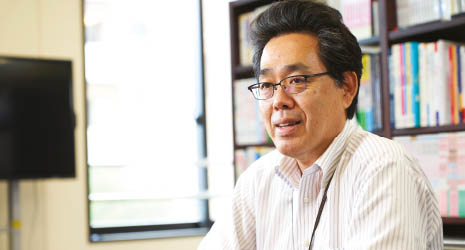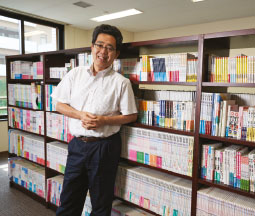Home > Highlighting JAPAN > Highlighting Japan September 2018 > A Society of Health and Longevity
Highlighting JAPAN


Preventing Dementia with Learning Therapy
According to Japan’s Ministry of Health, Labour and Welfare, the country’s number of dementia patients is expected to reach around seven million by 2025—including one person out of five over the age of sixty-five. One increasingly popular measure considered effective in clearing the fog of dementia is learning therapy.
T he learning therapy method was created as a joint project between Professor Ryuta Kawashima of Tohoku University’s Institute of Development, Aging and Cancer and the international Kumon Institute of Education tutoring school franchise.
The curriculum is simple. First, patients with dementia read aloud stories they enjoyed as children. Next, they do simple calculations and check their answers. (The level of difficulty is decided through placement tests taken beforehand.) The questions are selected according to the individual’s maximum learning ability and designed to be grasped quickly. After they complete the test, the patients are graded according to their reading ability and calculation results, discuss topics they have read about, and talk about recent incidents that have occurred around them. This is all accomplished in just thirty minutes.
Reading aloud, calculating and communication as a form of learning is based on fMRI (functional magnetic resonance imaging) and light topography studies. fMRI measures brain activity using layered images obtained through MRI scans, while light topography is a unique technology that measures blood flow to the brain and visualizes brain activity using near-infrared spectroscopy. When a person reads aloud, calculates or communicates, the brain’s prefrontal cortex, which serves as the body’s command center, becomes active. The content the patient is learning is not difficult, and there is minimal pressure.
“However, the results were better than we expected,” says Kawashima. “After incorporating learning therapy at a facility for the elderly in Fukuoka in 2001, there were some clear improvements over the following two months. For instance, residents began to look happier, studied willingly, and some even managed to stop wearing diapers.”
The results made a positive impression on those surrounding the patients as well. The better the patients became, the more motivated facility staff became in their work. Families of the patients were also more at ease.
“We also saw positive results regarding medical expenses from a third-party organization,” Kawashima notes. “Even after subtracting the textbook and labor fees, there was a savings of approximately 200,000 yen per patient for medical expenses annually.” He adds that 1,400 facilities and 210 local governments in Japan are currently using learning therapy.
The method is also being used overseas. In America it has become known as SAIDO Learning, and has been spreading since 2011. Countries such as Germany and Italy that also have large elderly populations have shown interest in the method as well.
Given the growing number of elderly citizens, Professor Kawashima offers some advice to younger generations. “You need to be prepared and take preventive measures against dementia,” he states. “For instance, exercising regularly has proven effective against the disease. Joining a study group, being careful of your nutritional balance and interacting with your surroundings can also help.”
As the next step in learning therapy, Kawashima plans on starting a venture organization within Tohoku University to create a wearable device for near-infrared spectroscopy that can easily display how active the brain’s prefrontal cortex is. By placing a small box (5 cm x 3 cm) on the patient’s forehead, an observer will instantly be able to see how active the brain is on a smartphone or a specialized device when the patient begins to learn.
Kawashima remains intent on devising other new preventive measures against dementia through neuroscience. Hopefully he and Japan will find keys to preventing or at least lessening this debilitating disease all over the world.
© 2009 Cabinet Office, Government of Japan








